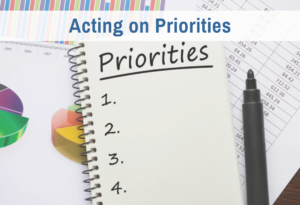Emotions are our automatic life-reporting systems. We experience joy in our successes, eagerness to achieve the next goal, fear of a deadline we need to pay more attention to. Emotions are crucial to enjoying life and keeping it on track.
Unfortunately, emotions can also be wildly inappropriate, immensely disruptive, and unnecessarily paralyzing. To avoid the destructive effects of such feelings, many people are tempted to suppress them. But repeated suppression shuts down a person’s emotional faculty—much to his detriment.
A more constructive way to deal with disruptive emotions is to recalibrate them, i.e., bring them in line with an objective evaluation of the situation. [See Note 1] You can learn this skill from Mind Over Mood by Dennis Greenberger and Christine Padesky.
The method taught in Mind Over Mood was first developed by Aaron Beck, the originator of the cognitive school of psychotherapy. He observed that emotions result from an automatic (subconscious) process of identification and evaluation. [See Note 2] Therefore, new factual information can change an emotion in an instant. For example, suppose you were frustrated that a car in front of you was stopping for no apparent reason. As soon as you saw that the driver was avoiding a collision, your frustration would vanish.
Beck observed that many disruptive emotions are based on mistaken or illogical “automatic thoughts.” In effect, your subconscious jumped to a conclusion. Beck found that by systematically identifying and testing these automatic thoughts, you can align the emotions with an objective assessment of the facts.
The method he developed is explained by his associates, Greenberger and Padesky, in their step-by-step workbook, Mind Over Mood. The process of recalibrating feelings involves both introspection and logical analysis. First you identify your feelings and the situation that prompted them, then you identify the “automatic thoughts” that gave rise to the feelings, then you test the validity of the thoughts, and finally you re-evaluate the situation. The crucial step is testing the validity of the “automatic thoughts.”
To help one test validity, Mind Over Mood offers a list of specific questions to ask oneself. They are gentle, effective questions that help to change one’s perspective and notice overlooked facts. Here is a sampling:
“When I am not feeling this way, do I think about this situation any differently? How?”
“Are there any small things that contradict my thoughts that I might be discounting as not important?” “Have I had any experiences that show that this thought is not completely true all the time?” (Mind Over Mood, p. 70)
So, for example, suppose I felt angry that someone had telephoned me, because the phone conversation interrupted my work. An outside observer could see that it is illogical to be angry with the caller—if I don’t want to be interrupted, I shouldn’t answer the phone. If I were calm, that’s what I’d think, too.
But in the heat of the moment, I might feel angry. Let’s say the “automatic thought” that came to mind was, “I hate interruptions.” If I were to test this thought with Greenberger and Padesky’s questions, I would remember that I do not always hate interruptions—sometimes I am eager for one. And, of course, I’d notice that I had answered the phone, which indicated that maybe I wasn’t so averse to this interruption. My anger would dissolve as I began to see my role in being interrupted.
Greenberger and Padesky’s questioning procedure helps me to look for evidence for and against my “automatic thought.” It is one of the important reasons I recommend Mind Over Mood. Some cognitive therapists suggest that to test “automatic thoughts” one should simply look for logical distortions. I find that when I’m upset, looking for evidence is easier than looking for distortions. Once I have the evidence, I gain a new, clearer perspective, and I can identify any distortions in my old thinking.
Sometimes recalibrating one emotion reveals another, hidden emotion. For example, after recalibrating my anger at being interrupted by the phone, I might be angry at myself for having taken the call. I might need to do another round of emotional recalibration to deal with feeling guilty for this small lapse in self-discipline.
I find that recalibrating emotions is a terrific way to deal with emotional distractions at work. Often a few minutes spent analyzing a disruptive emotion can help me resolve an issue and let it go. And even when I don’t resolve the issue instantly, going through this process gives me an objective perspective to help me decide what to do.
This method can’t eliminate all distressing emotions—sometimes distressing emotions are based on perfectly logical thinking. What it does do is to ensure that your emotional reactions are scaled to the situation. You never have to feel at the mercy of an “out of control” emotion.
The ability to recalibrate one’s emotions is a crucial skill for maintaining emotional health. For those who want to develop it, I recommend Mind Over Mood.
Note 1: The method I am calling “recalibrating emotions” is referred to by Greenberger and Padesky as “making a thought record.” Beck calls it “the three-column technique.” David Burns, another cognitive therapist, calls it “making a mood log.”
Note 2: Ayn Rand made the same observation. “Subconscious identification and evaluation” is her terminology. Beck would call this an automatic interpretation or appraisal of the situation.
Book Information: Dennis Greenberger & Christine Padesky, Mind Over Mood:Changing the Way You Feel by Changing the Way You Think, Guilford Press, 1995.








I used Mind Over Mood in the 1990’s and before it David Burns’ Feeling Good to deal with my depression. I needed medical treatment as well, but the exercises in those books were motivators for me.
Larry Radtke
Yes, there is no substitute for thinking through the issues. David Burns Feeling Good Handbook is also a good resource.